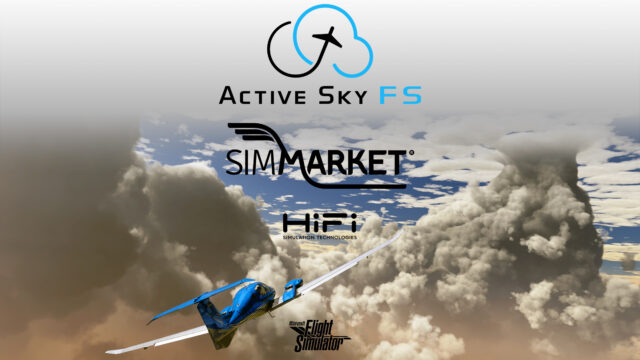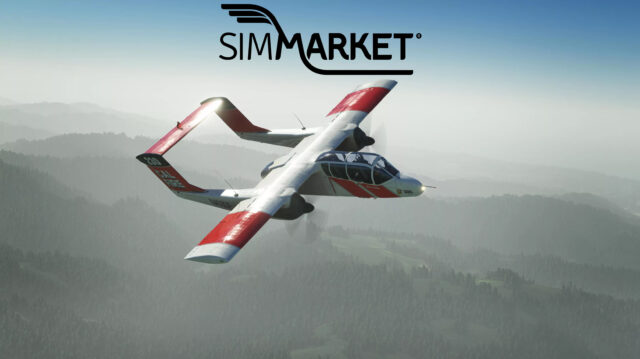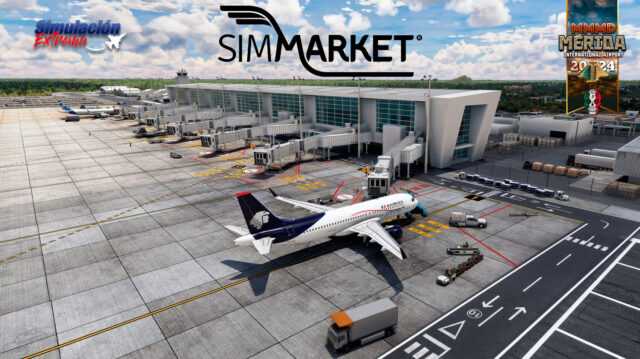 Aerosoft is known to offer us virtual pilots a peculiar add-on once in a while. The Hoffman H36 Dimona is the continuation of this tradition. Being a motor glider, it has the long wings and sleek tail of a glider, but also has an engine in front, and the classic 2 seater, side-by-side, cockpit of a touring aircraft. So, a strange aircraft by itself, but how good is Aerosofts representation in FSX?
Aerosoft is known to offer us virtual pilots a peculiar add-on once in a while. The Hoffman H36 Dimona is the continuation of this tradition. Being a motor glider, it has the long wings and sleek tail of a glider, but also has an engine in front, and the classic 2 seater, side-by-side, cockpit of a touring aircraft. So, a strange aircraft by itself, but how good is Aerosofts representation in FSX?
With its 16m (52ft) wingspan, while only having a 6.85m (22ft) long fuselage, the glider origins of the Dimona are clear when you see the aircraft. But nonetheless, it has the relatively bulky front end and sturdy landing gear of an engine driven aircraft. The aircraft is powered by a small engine, that only delivers 80hp at 3400 rpm. Even worse, the propeller is limited to 2900 rpm, so you don’t even get to that 80hp, you’ll be stuck somewhere around 70hp. Not much indeed, and combine this with very long wings, and a fixed tail wheel landing gear, and you see that you won’t be going anywhere fast with this aircraft. The good side however, is that you won’t use that much fuel either, certainly when you stop the engine in flight, and give the Dimonas glider characteristics a try. Aerosoft claims this is the first high end motor glider for FSX, and as far as I know, they’re right. A peculiar aircraft, from a company that has proven they can pull of peculiar like the best in the past.
Installation:
As usual with Aerosoft products, installation is very straightforward and trouble free. The Dimona isn’t protected by the new Aerosoft Launcher, but the Launcher is included as an option in the installation nonetheless. I have no problem with the Launcher, in the contrary, I think it’s a good program. But, for those who don’t know it yet, I’ll go over the entire installation process here.
Obviously, the first step is buying the Dimona, either from Aerosoft themselves, Simmarket, or any other website that sells it. Upon purchase, you will receive a serial, and a download link. After downloading the file, which is a .zip file with a simple .exe in it, you just run that .exe installer. The installer will ask you to choose your language, click ‘agree’ or ‘next’ a couple of times, and enter your email address and serial key. It will also ask you to install the Aerosoft Launcher or not. If you don’t already have it, or have an older version, it’s not a bad idea to choose to install it. After the actual moving of files, the Aerosoft Launcher will be installed. After that, installation is finished.
The Aerosoft Launcher has some very useful features, even if it’s not used for product validation, as is the case with the Dimona. First of all, it has a built in browser, that defaults to the Aerosoft home page, so you can check the latest news from Aerosoft. Second, it has direct links to all manuals per product, so you don’t have to go searching yourself. And best of all in my opinion, it can be used to check for product updates. This way, you don’t have to go check all products you have installed manually. Of course, the main use of the Aerosoft Launcher is to reduce piracy in our hobby. Not applicable to the product in this review, the Dimona, but there’s some very clear and very good explanations on the Aerosoft forums on what is sent to Aerosoft and what isn’t when a product does require validation. If you have questions about it, I’d suggest reading those sections in the forums.f
When installation of the Dimona is finished, you have the actual aircraft installed in FSX, in 3 variants. Not only are the liveries of these 3 different, their cockpit layout is as well. Besides that, you get a general manual, 3 checklists (in different languages), and a C4 Competition (a gliding flight computer) manual in different languages.
Exterior:
The exterior of this peculiar aircraft is something worth taking a look at! First of all, very good modeling. The 3D model is very detailed and very smooth. It’s clear there was no holding back in the creation of this model. But the model isn’t everything of course. A model needs to be covered in textures. The textures used on the Dimona are very clear and very crisp. No blurries, not warped sections. You can zoom in a lot, without having to fear losing any of the clarity of the textures. There’s also hardly any wear or dirt visible on the textures. The only I see is behind the exhaust, caused by exhaust gasses. Mostly, I like an aircraft that shows it has been used. But small personal aircraft like this are generally kept quite clean. And this applies to gliders in particular, as their performance affected by how clean or dirty they are. So, although I prefer aircraft that have some history, in this case a clean aircraft looks realistic to me.
So, a good exterior so far. But the best part is yet to come: the animations. Aerosoft added a couple of very neat animations on this exterior model. They are closely related to the fact the Dimona is built as a motor glider. First, those long wings on this aircraft tend to bend quite a lot under certain circumstances. The developers didn’t hold back on this animation. The wing bending is there in a lot of detail, and very realistic in flight. The only thing off I noticed about is that it sometimes does strange things upon liftoff or touchdown, with very strong deflection in an unexpected direction. Apart from that, it does look very realistic in flight.
A second animation worth mentioning is related to the ailerons. Again related to being a motor glider, this aircraft has long wings, yet is quite heavy, so those long wings have to deal with a lot of stress, especially during powered flight. Therefore, the ailerons also act as load-limiting devices. This just means that both ailerons are deflected upwards when the wings are bending up. The results are simple: less lift on the outside of the wing, less bending and thus less stresses on the wing. This is also modeled in FSX. It’s very visible if you make some airspeed, and suddenly pull the stick back. You’ll see the ailerons deflect upwards in the exterior model, and of course in the wings of the interior model as well. However, the best animation is the propeller, but I’ll keep that for the ‘panels and systems’ section.
Interior:
As with the exterior, the interior modeling is very, very good. Clear, detailed and smooth. Everything, from the gauges and dials, over the knobs, to the propeller and wings is very neatly modeled. I’m not as positive about the textures though. They look realistic, and are once again very detailed and crisp. My only problem, is that some labels next to knobs and levers are very hard to read if you don’t zoom in a lot. Not because a lack of resolution, but because they’re too small and too fine. I have no problem believing they’re realistic, but they have to be usable as well, in my opinion. The animations however, are again very good. The exterior animations that are visible from the cockpit are repeated in the interior (spoilers, wings, ailerons, prop…), and everything in the cockpit moves very smooth. Gauge needles, knobs, levers, it’s all animated, and they’re all animated very well. The gauge needles will even move depending on G-forces and airframe vibrations. This is most notable on the ground, during taxi, takeoff or landing. And it doesn’t end there: there’s also the canopy that can be opened in a very nice and smooth animation. The same with the ventilation windows in the canopy. But the best thing of all you’ll see in the VC, is something very realistic, yet very rare in FSX: bugs on the windscreen. If you’re flying in good weather, you’ll gradually see dead bugs appearing on the windscreen! Very nice feature. To get them off, you can clean your aircraft on the ground. Also noteworthy here, is that the 3 different variants all have different cockpit layouts. There’s one with only basic instrumentation, there’s one for VFR flight in controlled airspace, and there’s one equipped for gliding, with the C4 Competition gliding computer.
Panels and systems:
About 2D panels, I can keep it short. There’s only one, and that’s a 2D popup of the (custom) GPS. Apart from that, no 2D panels. I don’t miss a thing, as I prefer the VC, but I do understand that some people prefer a 2D panel. Even so, I’d suggest giving it a try nonetheless. It is a very good VC, and the Dimona isn’t an aircraft to be flown by the numbers. It’s an aircraft that’s to be flown by feel.
As for systems go, there are a couple of things that stand out. First of all, there’s that C4 Competition gliding computer. It’s also to be found in the Aerosoft Discus X, by the way. The C4 Competition is a very comprehensive instrument, very useful for gliding. Among a lot of other things, it can calculate at what altitude you will reach a waypoint or calculate your final glide to the airport. It’s so complete, and so much like the real instrument, Aerosoft got permission to just ship the manual from the real thing with the Dimona (and the Discus).
Another thing of note is the custom GPS. No longer do you have to use the default Garmin 500 GPS. For the Dimona, a custom GPS unit was programmed, based on the Garmin GPS III. This is a battery powered, black-and-white GPS unit. I’ve used one of these in real life once, and I can say, this one looks exactly like the real deal. The manual fully describes the GPS unit, and all its functions and features.
But the best and most impressive system on the Dimona is, without a doubt, the propeller and engine. The small 80hp engine is coupled to a constant-speed prop, that limits it to 2900 rpm. First thing of note is that the engine will fail, and can even break, if not used correctly. For example, leaving the choke open after startup, will drown the engine, which will start sputtering, and eventually fail. Similarly, if you turn the propeller control unit off, the propeller will act as a fixed pitch prop, making it possible to go up to 3300rpm, but keeping this up for more than a couple of minutes will break the engine, causing you to look for an emergency landing spot. When you stop the engine, it will start ‘dieseling’, which means it will keep igniting for a while with ignition turned off. Then the next part: that propeller control unit. This control unit has 3 master settings: off (which you shouldn’t use), auto, or segel (gliding). In off, the prop will be a fixed pitch one, as described above. In auto, the unit will govern the rpm, and lets you dial a desired rpm in the range from 1900 to 2900. Segel will feather the prop, to reduce drag while gliding. Segel should only be selected after the engine is turned off, and it will take an incredibly long 1 minute and 20 seconds to move the propeller from full fine to fully feathered or back. So, forget about quickly turning the engine on if you screw up while gliding. I already said the propeller itself is very nicely animated, and there’s good reason for that. This is, by far, the most detailed propeller system I’ve ever seen in FSX. The propeller will actually respond to the situation in flight. If you put it in the gliding position, fully feathered, it will keep turning, first fast, then slower, and will only stop turning if it’s almost completely feathered. The lower the airspeed, the sooner will the prop stop turning. And even when fully stopped, it will still respond to unusual flight situations. Very high speed, side slips or stalls will have a visible effect on the prop. And although the Dimona isn’t certified for it, you can even perform and air start by unfeathering the prop, switching the ignition on, and keeping the speed high. The engine will start without you touching the start button.
One final system detail I’ll be talking about is purely simulation related, yet very nice nonetheless. The Dimona X incorporates an automatic panel state save/load feature. After landing and shutting down the engine, the Dimona will automatically save all knobs, levers and settings. To make sure this works correctly, you have to wait 10 seconds after shutdown before quitting FSX or choosing another aircraft. The next time you select the Dimona for flight, it will load the exact settings it saved last time. So, instead of starting again every time, you’ll get the same aircraft you left last time when you load the Dimona.
Flight dynamics:
Everything I talked about earlier demonstrates this is not just any add-on. But I’ve not yet touched the main emphasis of this product. That will be the flight dynamics. Being a combination between a motor aircraft and a glider, the real Dimona has a very specific handling. Aerosoft managed to get this exact behavior in FSX! There are several add-ons available that push de boundaries of what FSX can do, and the Dimona X certainly is one of them. Taxiing and takeoff is easy, and nothing special. But in the air, the Dimona has its quirks. Like a glider, the long wings make sure that the Dimona needs lots of rudder action to keep turns coordinated. Apart from that, the Dimona is easy to fly, as long as you respect it’s limits. It doesn’t fly fast, doesn’t climb fast, and doesn’t decent fast. Keep that in mind, and you’ll be fine. But the real power of the Dimonas flight model comes to show when you fly where FSX doesn’t do very well: the edge of the envelope. Flying the Dimona to its stall speed is unlike other aircraft for FSX: realistic, predictable and repeatable. It will even do realistic spins. Aerosoft places a lot of emphasis on the accuracy of the flight model, and for good reason. It’s one of the very best I’ve seen in FSX so far!
Sounds:
Aerosoft once again pulled out their Aerosoft Sound Control (ASC), which makes it possible to add lot’s of custom sounds to aircraft. Aerosoft has been using this for years now, and with good reason: it’s a very good system. Every knob, switch or event in the Dimona has its own sound. And it’s not limited to just knobs in the VC. The engine sound will change depending on how the engine is working and the sound of the airflow over the canopy will change if you open the ventilation windows.
Conclusion:
A very nice step for glider pilots that want to get into motor aircraft, or the other way around, Aerosofts Dimona X is way more than just a step in between. It’s a unique, very detailed product that will keep you happily occupied for hours, exploring this new way of flying, exploring it’s features, and learning to live with its quirks. The Dimona X doesn’t stand out because of just one or two top features. Instead, it stands out because the entire package is rock solid and well balanced. I gladly recommend this product to anyone that likes small GA aircraft, gliders, or just wants something new to try.
Like:
- Good visuals
- Amazing flight model
- Very realistic engine and prop behavior
Don’t like:
- Some odd movement of the wings upon rotation and touchdown
Useful links:














![[Video🎬] New Trailer 4K for Turkish Airports MSFS by SceneryTR Design – Istanbul – Ankara Trabzon by SIMMARKET](https://www.simflight.com/wp-content/uploads/2024/04/SceneryTR_thumb.jpg)
0 Responses
I was brought in right at the very end of testing the Dimona to help track down a problem that only happened on certain PC system configurations (of which my wife has one, hence my being asked to test) and I fell in love with it on the first flight.
It’s a fantastic model of a very interesting aircraft and as you say, Lars, an excellent all round package.
It’s certainly not for the fast jet jockeys who want to go everywhere at mach numbers rather than being able to take in the sites, but it’s great fun to fly around the scenery in and just to see what you can do with it.
I have to agree with Lars, I’d thoroughly recommend it.
Ditto. It is sufficiently different yet actually as enjoyable as any of the micro-managed tubeliners out there and is another of those few – those special few – that can actually create a simulation of `being there`.